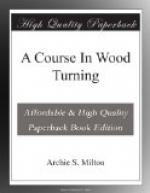In wood turning a vast field for design and modeling is opened, and art and architecture can be correlated. The pupil will see for himself the need of variety in curves and must use his judgment in determining curves that are so harmonious and pleasing that they will blend together. If properly taught the beauty in the orders of architecture can be brought out in the making of the bead, fillet, scotia, cove, etc.
A feeling of importance is excited in a boy when he sees his hands shaping materials into objects of pleasing form. Wood turning properly taught awakens the aesthetic sense and creates a desire for the beautiful. The boy or man who has learned to make graceful curves and clean-cut fillets and beads will never be satisfied with clumsy effects which are characteristic in cheap commercial work, made only to sell.
Success in turning depends on the following:
1. Care of lathe, tools, selection
of materials.
2. Study of the scientific elements
of—
a.
Revolving bodies.
b.
Points of tangency.
c.
Study of results by reasoning and observing.
3. Development of technique and exactness.
4. Correlation of mental and motor
activities.
CHAPTER II
THE LATHE
The sizes of turning lathes are given as 10”, 12”, etc. These figures denote the diameter, or size, of the largest piece of work that can be turned on them. The measurement is taken from the center point of the live center to the bed of the lathe (usually 5” or 6”) and is one-half the diameter of the entire circle. The length of a lathe is determined by the length of a piece of work that can be turned. This measurement is taken from the points of the live and dead centers when the tail stock is drawn back the full extent of the lathe bed. Fig. 1 shows a turning lathe with sixteen principal parts named. The student should learn the names of these parts and familiarize himself with the particular function of each.
CARE OF THE LATHE
The lathe should be oiled every day before starting. At the end of the period the lathe should be brushed clean of all chips and shavings, after which it should be rubbed off with a piece of waste or cloth to remove all surplus oil. All tools should be wiped clean and put in their proper places. If a student finds that his lathe is not running as it should, he should first call the attention of the instructor to that fact before attempting to adjust it; and then only such adjustments should be made as the instructor directs.




